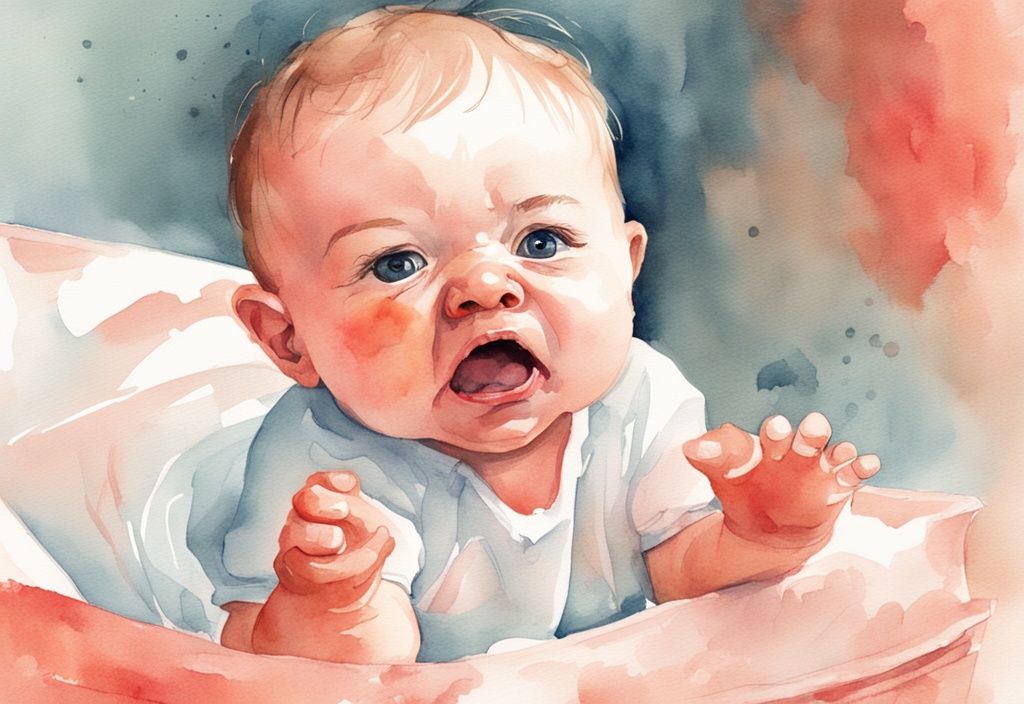Hey there, are you tearing your hair out, wondering “Why does my baby hate diaper changes?” You’re not alone! This is a common concern creeping into so many parents’ minds. It can be daunting when our tiny tots wail or squirm during something as routine as changing diapers. Prioritizing comfort and peace during these unavoidable moments is crucial, not just for our babies, but for our sanity too!
You landed here looking for answers, and that’s exactly what you will get! This article uncovers the common hitches and glitches causing your baby’s diaper changing resistance – the physical discomforts, the emotional strains, you name it.
By the end, you’ll be armed with effective strategies from a fellow mama who’s been there. Get ready to breathe a sigh of relief and turn these moments into more peaceful ones. It’s all about understanding, adapting, and sprinkling a little patience and love. Let’s dive in!
Understanding Why Your Baby Dislikes Diaper Changes
Diaper changes can often be a battleground, leaving you and your baby frazzled. There are various reasons why your little one might resist, ranging from physical discomfort to emotional factors.
The Role of Physical Discomfort During Diaper Changes
Effect of Cold Wipes and Air
Exposure to cold wipes and air can be jarring for your baby, causing a sudden chill that makes them fussy and uncomfortable. This discomfort often leads to crying or resistance. You can warm the baby wipes in your hands before use and ensure the changing surface is warm and cozy. This helps eliminate that sudden rush of cold air, making the whole process much more comfortable for your little one.
Discomfort Caused by Diaper Rash or Health Issues
Diaper rashes are a common culprit behind why your baby hates diaper changes. The itching, burning, and overall soreness associated with a diaper rash can make every diaper change excruciating for them. Other health issues like urinary tract infections or skin conditions can intensify their discomfort. Using a diaper cream specifically formulated for babies can help soothe their skin, providing a protective barrier to ease pain and prevent future rashes.
Unsuitable Changing Surfaces
Babies grow quickly, and a changing table that once seemed perfect can soon become uncomfortable or even too small. If your baby seems restless during diaper changes, it might be the surface they’re lying on that’s causing the discomfort. Switching to portable changing trays or soft, cushioned surfaces can make a world of difference. A comfortable and secure changing area minimizes physical discomfort and makes diaper changes more tolerable.
Emotional & Psychological Factors Affecting Diaper Changes
Interruption of Activities
As babies grow older, they become more engrossed in their activities. Rolling, crawling, or simply exploring their surroundings, an unexpected diaper change can feel like an unwelcome disruption. This not only interrupts their fun but also their practice of newly acquired skills, leading to frustration and resistance. Understanding your baby’s need for uninterrupted play can help you schedule diaper changes during natural breaks in their activities, reducing their irritation.
Past Negative Diaper Changing Experiences
Negative past experiences, like diaper rashes or discomfort, can make babies wary of diaper changes. They may cry or resist out of fear of recurring pain or discomfort. Consistency in providing a painless and smooth diaper-changing experience is vital to preventing negative associations. Over time, keeping the process soothing and comfortable can help alleviate your baby’s anxiety and make diaper changes a less dreaded routine.
How to Tell if Your Baby Dislikes Diaper Changes
Understanding why your baby hates diaper changes is key to ensuring their comfort and making the experience less stressful for everyone involved.
One of the most telling signs is observing your baby’s reactions during diaper changes. Is your little one crying or fussing persistently? This is a clear sign of distress and displeasure.
Another hint is when your baby refuses to lie still. Generally, babies cooperate when they’re comfortable. If yours is constantly moving or rolling away, it’s a signal that they’re unhappy with the diaper change. Such behavior often stems from discomfort or a desire to avoid the process altogether.
Arching the back is another common sign of distress. An arched back can indicate that your baby is uncomfortable, possibly feeling unsafe, cold, or in pain from conditions like a diaper rash. Similarly, clenched fists or legs show that your baby is tense and uncomfortable. This reaction is more noticeable in older infants who are more aware of their surroundings and their discomforts.
Turning the head away and avoiding eye contact are subtle but significant signals. These behaviors demonstrate your baby’s attempt to escape the situation and may be tied to previous negative experiences or disruptions to their activities. Babies often use these cues to express feelings of insecurity or discomfort.
By observing these behaviors closely, you can identify whether your baby hates diaper changes. Taking proactive steps to address underlying issues—like ensuring a comfortable change environment or using warm wipes—can make diaper changes smoother. Understanding and responding to these signs can minimize stress for both you and your baby. For additional guidance, you might want to explore how long you should leave your baby in the crib if not napping to ensure a stress-free environment. how long you should leave your baby in the crib if not napping.

How to Make Diaper Changes More Enjoyable
Diaper changes don’t have to be a dreaded task filled with cries and wriggles. Here’s how to ease the process and keep your baby comfy.
Preparation Strategies for Smooth Diaper Changes
Organizing All Supplies Prior to Diaper Change
Before starting the diaper change, gather all essential supplies and keep them within arm’s reach. Diapers, wipes, a clean changing pad, and diaper cream should be readily accessible. By having everything prepared, you can streamline the process, making it quicker and less stressful for both you and your baby. An organized nursery setup can significantly reduce fussiness, helping your baby stay calm.
Selecting a Comfortable Diaper Change Area
Choose a diaper change area that is clean, comfortable, and well-lit. A well-lit space ensures you can see clearly and manage the process efficiently. Avoid cold changing surfaces, as they can cause discomfort. Using portable changing trays can provide flexibility and convenience, allowing you to change diapers in different areas of the house. Make sure the changing area is comfortable and soft to keep your baby relaxed.
Techniques to Comfort Your Baby
Using Warm Wipes
Cold wipes can be startling and uncomfortable for your baby. Warm them in your hands before use to ensure a gentler touch. This simple step can make a huge difference, helping to prevent diaper rash and ensuring your baby stays comfortable. Warm wipes create a more pleasant experience, reducing the likelihood of crying and resistance during diaper changes.
Maintaining Ambient Temperature During Changes
Maintaining a suitable ambient temperature can prevent your baby from getting chills during diaper changes. Ensure the room is warm enough to keep your baby cozy and comfortable. You can also drape a small blanket over the baby’s torso while changing the diaper to maintain warmth. A warm environment helps alleviate discomfort caused by cold air, making the whole process smoother.
Distracting Baby During Diaper Changes
Employing Toys and Baby’s Favourite Objects
Distraction is an effective technique for keeping babies calm during diaper changes. Introduce toys or objects that your baby loves and reserve them exclusively for diaper-changing times. This strategy can transform diaper changes into a positive experience, diverting your baby’s attention and reducing resistance. The anticipation of playing with a favorite toy can make these moments more enjoyable.

Communication Methods to Soothe and Engage
Narrate the diaper-changing process to your baby, explaining each step as you go. This helps your baby understand what’s happening and can ease anxiety. Use gentle reassurance by talking or singing to create a calm and positive atmosphere. Engaging your baby by asking for their “help” or involving them in small tasks can make them feel more involved, decreasing resistance. Effective communication builds trust and can turn diaper changes into bonding moments.
Keeping up a Positive Diaper Change Routine
A positive diaper change routine can transform a stressful task into a peaceful and even enjoyable experience for both you and your baby. From establishing a consistent schedule to creating a soothing environment, there are several strategies to make diaper changes less daunting. Let’s delve into some practical tips you can integrate into your routine to address common concerns like why your baby might hate diaper changes.
Crafting a Consistent & Stress-Free Diaper Change Routine
Maintaining a Specific Schedule for Diaper Changes
Establishing a consistent schedule for diaper changes can truly be a game-changer. Not only does it contribute to a hygienic environment, but it also reduces the likelihood of your baby developing infections. A predictable routine helps make the process less stressful and more routine for both you and your baby. This is a significant step in addressing why your baby might hate diaper changes. By knowing when to expect a diaper change, your baby can be more mentally prepared, which may reduce resistance and fussiness.
Steps to Avoid Hurry and Stress During Changes
Rushing through diaper changes often increases stress for both you and your little one. Instead, proceed calmly and talk your baby through each step. Explain what you’re doing in a soft, reassuring voice—this can make the experience feel more secure and less abrupt. Patience and understanding are key. The more relaxed and composed you are, the more your baby will pick up on those calming cues, reducing anxiety and making the diaper-changing process smoother.
Techniques to Create a Relaxing Environment During Changes
Setting a Calm Atmosphere
Creating a calm and engaging environment can significantly improve the diaper-changing experience. Soft lighting can create a cozy atmosphere, while soothing music can distract and relax your baby. Incorporating gentle massage during or after the change can also help calm your baby and make them more comfortable. All these elements contribute to a serene and pleasant diaper-changing environment, alleviating some of the reasons why your baby might hate diaper changes.
Including Fun and Bonding Activities
Transforming diaper changes into fun and bonding activities can encourage your baby’s participation. Sing a favorite song, play gentle games, or narrate a fun story. This can make the time feel more like a special bonding moment rather than an unwanted interruption. By incorporating these enjoyable elements, you can help shift your baby’s perception and make diaper changes a more pleasant and engaging experience.
When Should You Discuss Diaper Changes with Your Pediatrician?
Understanding why your baby might resist diaper changes can be a labyrinth of emotions and concerns. Below are some key scenarios when consulting with your pediatrician becomes essential to address the distress your little one is facing during diaper changes.
Persistent Concerns About Baby’s Behavior or Well-being
It’s normal to wonder why does my baby hate diaper changes, especially if the resistance is persistent. If after trying several strategies to make diaper changes smoother, your baby still shows intense discomfort, it’s important to consult with a pediatrician. Persistent fussiness, excessive crying, or notable changes in behavior during diaper changes could signal underlying issues that need professional assessment.
Recurring Issues with Severe Diaper Rash
Severe diaper rash not only causes significant discomfort for the baby but also heightens the overall stress during diaper changes. If you’re managing a rash that persists despite using recommended creams and maintaining hygiene, it’s a clear indicator to involve your pediatrician. They can help determine if there’s an infection or allergy that needs medical attention.
Unmanageable Distress During Diaper Changes
When diaper changes are consistently accompanied by unmanageable distress—such as inconsolable crying, excessive arching of the back, or noticeable fear—it goes beyond typical fussiness. This level of distress may be linked to physical ailments or psychological stressors that require a deeper evaluation by a healthcare professional. Understanding why does my baby hate diaper changes through a pediatrician’s insight can lead to effective solutions.

Possible Health Conditions Affecting Diaper Changes
Sometimes babies may resist diaper changes due to underlying health conditions such as urinary tract infections or other skin-related problems. These conditions often go unnoticed without professional diagnosis. If you observe signs like fever, unusual urine odor, drastic changes in skin condition, or general discomfort, it’s essential to discuss these with your pediatrician promptly.
Concluding Insights: Overcoming Diaper Change Hurdles
Recognizing and addressing why your baby might hate diaper changes is the first step to making this daily task less stressful for both of you. From physical discomfort to emotional interruptions, understanding these hurdles can help ease the tension.
Understanding the Root Causes: Physical and Emotional Discomforts
Identifying the reasons behind your baby’s resistance to diaper changes can be a game-changer. Physically, the chill from cold wipes and air exposure can make babies fussy. Imagine the sudden shock of a cold wipe on your skin—brr! Not exactly pleasant. Diaper rash or other skin conditions can also make diaper changes quite painful. Tackling these physical discomforts can significantly improve the experience for both you and your little one.
Emotionally, babies may start to resist diaper changes because they’re interrupting their fun activities. Just when they’re in the middle of an exciting crawl or play session, diaper change time strikes! Older babies, in particular, find this especially frustrating. And if they’ve had a bad experience before, like a sore bottom from a previous rash, they might develop fear or resistance.
Strategies for Tackling Diaper Change Challenges
Patience, dear parent, patience! Rushing through diaper changes can amplify stress and discomfort. Stay calm and speak gently to your baby during the process—reassuring words work wonders. A consistent routine also helps. If your baby knows what to expect, they may feel more secure and less fussy.
Specific strategies can make a big difference, too. Warm the wipes in your hands before using them, and ensure the changing surface is cozy. Toys or songs can keep your baby distracted and happy while you work. Finding a comfortable, clean, and well-lit area for diaper changes minimizes stress for both you and your baby.
Creating a Positive Environment
Turn diaper changes into bonding moments. Sing a silly song or chat about what you’re doing to keep the baby engaged. Soft lighting and soothing music can create a calm atmosphere, making diaper changes a bit more pleasant.
Your baby senses your mood, so staying calm and positive is key. By fostering a nurturing environment and addressing both physical and emotional needs, you’ll find that diaper changes can become less of a struggle and more of an opportunity for connection.
Remember, it’s about understanding why your baby hates diaper changes and using consistent, patient strategies to make the experience smoother. It’s all part of the beautiful, messy journey of parenting!
Frequently Asked Questions
Why does my baby cry during diaper changes?
Babies might cry during diaper changes for various reasons. Cold wipes can be quite a shock on their delicate skin. Diaper rash adds to their discomfort, and an uncomfortable changing surface doesn’t help either. Let’s not forget the emotional side—sometimes, they simply don’t like their activities being interrupted, especially if they’ve had unpleasant experiences in the past. If you’re dealing with stubborn stains, you might want to learn how to get yellow stains out of baby clothes to keep their wardrobe looking fresh.
How can I make diaper changes more pleasant for my baby?
To make diaper changes a bit more bearable, try using warm wipes and ensure the changing area is soft and comfy. A little distraction goes a long way—bring in a favorite toy or an interesting object to capture their attention. And remember, a calm and soothing environment can work wonders.
What should I do if my baby has a diaper rash?
If a diaper rash is troubling your baby, applying a baby-formulated diaper cream can offer relief and protection. Keep the diaper area clean and dry, and change diapers frequently to avoid further irritation.
Is it typical for babies to dislike diaper changes?
Absolutely, many babies aren’t fans of diaper changes. Physical discomfort, emotional factors, and those pesky activity interruptions can all contribute to their dislike.
When should I change my baby’s diaper?
Stick to a consistent diaper change schedule and swap out the diaper immediately when it’s soiled. This helps maintain hygiene and ensures your baby stays comfy.


